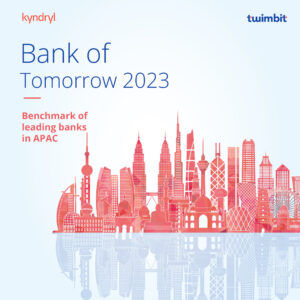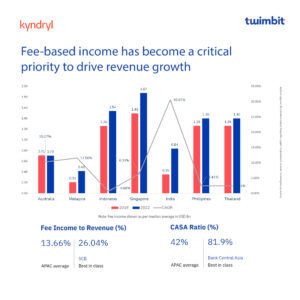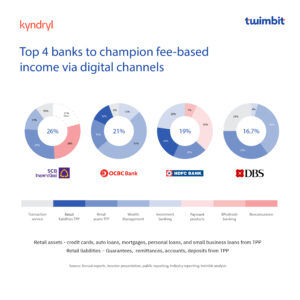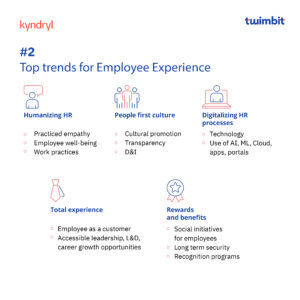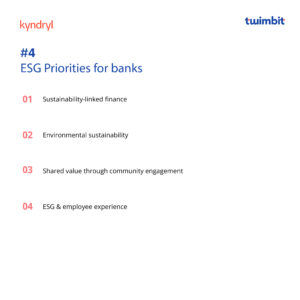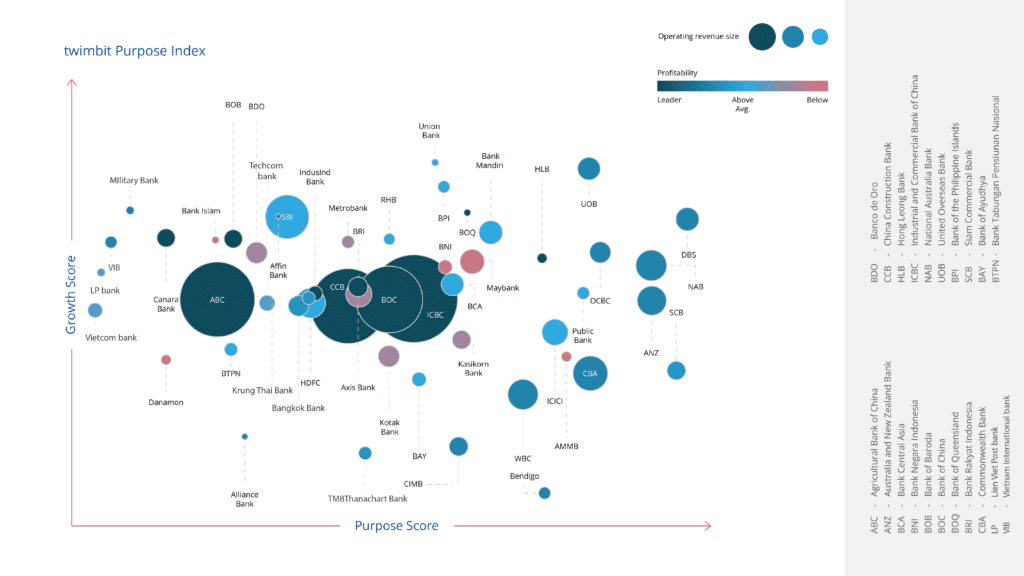Introduction
In today’s business landscape, companies must transcend the pursuit of mere shareholder value. We believe every organisation should uphold a holistic commitment to all its stakeholders. These stakeholders encompass shareholders, customers, partners/suppliers, the planet/society, and employees.
This report aims to uncover the journey of the top banks across the Asia Pacific region. Here, we meticulously assess the growth drivers that have propelled their success, benchmarking them based on these five foundational pillars. Moreover, this report offers a strategic view, highlighting how top APAC banks can triumph in the market by capitalising on purpose-driven growth opportunities.
twimbit Purpose Index
We benchmarked the top APAC banks with the twimbit Purpose Index across 4 key purpose pillars(Exhibit1):
- Customer experience (CX): Reimagine the CX strategy to drive business growth.
- Employee experience (EX): Create exceptional employee experiences to foster excellence.
- Supplier satisfaction (SS): Elevate supplier satisfaction to drive operational efficiency.
- ESG (Environmental, Social and Governance) impact: Unlock sustainable growth with positive ESG impact.
| Growth Score | The growth in revenue Y-o-Y (Year on Year) |
| Purpose Score | The aggregate purpose score for each pillar |
| Bubble Colour | The colours indicate the bank’s profitability |
| Size of Bubble | The size denotes the operating revenue size of the banks |
Recap 2021 vs 2022
- There are 16 new entrants in the twimbit Purpose Index
- SCB emerges as a winner among the new entrants with the 2nd highest purpose score, above-average profitability.
- DBS maintains its top position with the highest purpose score and above-average profitability.
- UOB bank is the leader in revenue growth. DBS and OCBC show an upward trend in Y-o-Y revenue growth.
- All Chinese banks (ICBC, BOC, ABC, and CCB) are the largest banks with the highest revenue size and above-average profitability.
- Australian banks (NAB, CBA, ANZ, and WBC) experience significant improvements, charting higher purpose scores compared to 2021. However, WBC indicated a downfall in its profitability.
Key financial highlights
- Chinese banks lead the APAC region in profitability, generating USD 762 billion in revenues.
- The total operating revenue for APAC banks amounted to USD 1.12 trillion in FY22 at a median average growth rate of 8.87%.
- Fee income in the region grew at a CAGR of 6.2% from 2018 to 2022, with SCB having the highest fee income to total revenue at 26.04%.
- The median average of cost to serve for APAC banks is at 45% with ICBC being the best in class at 26.5%.
- BPI reported the highest ICT spend to revenue ratio in the APAC region at 13%.
- APAC banks have an average ICT-to-Revenue ratio of 3%, with DBS being the best in class at 9.3%.
- In 2022, APAC banks achieved a 14-year high in profitability, with an average return on equity of 11.55%, surpassing the global range.
- The APAC average loan-to-deposit (LDR) stood at 87%, with ANZ, BOC, Axis bank and Bank Mandiri at ~85.8%, falling within the ideal range of 80-90%.
- APAC banks maintain an average CET-1 ratio of 15.3% to create a sufficient buffer against economic uncertainty.
How are banks unlocking growth?
Banks have embraced disruptive digitalization to cater to hyper-personalised customer needs and build award-winning customer journeys. We also saw ESG practices being the focal priority for most APAC banks in 2022. The aim to build sustainable financial practices with the ethical use of technology became a common theme among banking leaders.
Other factors that played a huge role in driving growth:
- Higher capital ratios
- Increase in net interest margins.
- Focus on achieving consistent CASA growth.
- Exploring alternate revenue generation avenues through non-interest income
- Translating ICT spending into profitable digital investments.
Fostering growth with a purpose
- #1 Customer experience – Reimagine the CX strategy to drive business growth
DBS, NAB, ANZ, UOB, and CBA are the top 5 banks excelling in customer experience (CX). These banks prioritize customer satisfaction by offering seamless digital banking solutions and personalized services. Their customer-centric approach has earned them recognition as leaders in delivering exceptional CX within the banking industry.
These banks spearheaded the shift towards a digital-first approach, leading the charge in digital transformation and adopting 5 key trends to reimagine the customer experience (Exhibit 2).
- #2 Employee experience – Create exceptional employee experiences to foster excellence
MB, BPI, DBS, SBI, and HDFC are the top 5 banks that excel in employee experience (EX). These banks prioritize the well-being and development of their employees, fostering a positive work environment and employee engagement. Their commitment to creating a supportive and rewarding workplace has earned them recognition as leaders in employee satisfaction within the banking industry.
These banks are shaping digitally progressive and resonant organisations through immersive employee experiences. Our research reveals 5 emerging trends that the banks today are beginning to adopt to enhance employee experience (Exhibit 3).
- #3 Supplier satisfaction – Elevate supplier satisfaction to drive operational efficiency
Create a more efficient and sustainable supplier ecosystem, foster stronger relationships, and drive operational excellence by focusing on:
- Diversity and Inclusion: Prioritise diverse suppliers and create inclusive procurement processes to foster trust, collaboration, and improved supplier satisfaction.
- Digital Procurement: Implement digital procurement solutions to streamline processes, enhance efficiency, and provide transparency.
- Environmental Sustainability: Embed environmental sustainability into procurement, such as sourcing from eco-friendly suppliers or implementing green initiatives to enhance supplier satisfaction.
- Transparency and Fair Treatment: Transparency in communication, fair negotiation processes, and prompt payments contribute to higher supplier satisfaction levels and long-term partnerships.
- #4 ESG impact – Unlock sustainable growth through positive ESG impact
Banks can achieve sustainable growth, address critical environmental and overcome social challenges by focusing on:
- Sustainability-linked finance: Encourage businesses to adopt environmentally and socially responsible strategies by offering financial products and services that incentivise sustainable practices, such as green loans or sustainability-linked bonds.
- Environmental sustainability: Emphasize environmental sustainability in all aspects of the bank’s operations.
- Shared value through community engagement: Support community development projects, invest in local businesses, and foster financial literacy to establish strong relationships and drive positive social impact.
- ESG & Employee Experience: Create a positive ESG-focused culture to attract and retain top talent as well as foster a sense of purpose among employees.
Bank of Tomorrow 2023 is a strategic report developed in partnership with Kyndryl.
For more detailed insights, download the Bank of Tomorrow 2023 report.


